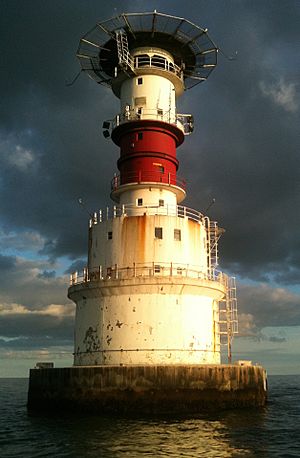Kish Bank facts for kids
 |
|
| Kish Bank Lighthouse in 2011 | |
| Location | County Dublin |
|---|---|
| Coordinates | 53°18.65′N 5°55.542′W / 53.31083°N 5.925700°W |
| Year first constructed | July 1963–July 1965 |
| Year first lit | 1965 |
| Automated | 7 April 1992 |
| Construction | reinforced concrete |
| Tower shape | telescopic cylindrical tower with four balconies, lantern and helipad |
| Markings / pattern | white tower with a red band |
| Height | 31 metres (102 ft) |
| Focal height | 29 metres (95 ft) |
| Original lens | catoptric |
| Intensity | two million candlepowers (three in fog) |
| Range | 27 nmi (50 km) |
| Characteristic | Fl (2) 20s. 24 hours light |
| Admiralty number | A5865 |
| NGA number | 6592 |
| ARLHS number | IRE-048 |
| Ireland number | CIL-0850 |
The Kish Bank (in Irish: Banc na Cise) is a shallow sand bank. It is located about seven miles (11 km) off the coast of Dublin, in Ireland. The Kish Bank is easy to spot because of the Kish Lighthouse. This lighthouse is a famous landmark for sailors and ferry passengers. They see it when they travel through Dublin Bay and Dún Laoghaire harbour.
Contents
Shipwrecks and the Kish Bank
The shallow waters of the Kish Bank have caused many ships to crash. Over the years, many vessels have been lost here.
Famous Shipwrecks
- The Vesper was lost in January 1876.
- The Norwegian MV Bolivar ran aground on the Kish Bank. This happened during a snow storm on March 4, 1947.
- Both the Vesper and Bolivar wrecks are popular spots for scuba diving.
The RMS Leinster Disaster
One of the most tragic events was the sinking of the RMS Leinster. This was a mailboat that carried mail and passengers between Dún Laoghaire (then called Kingstown) and Holyhead. On October 10, 1918, a German submarine attacked and sank the RMS Leinster. It went down four miles (6 km) east of the Kish Lighthouse. More than 500 lives were lost, making it the biggest single loss of life in the Irish Sea. In total, 55 shipwrecks are recorded for the Kish Bank area.
The Kish Lighthouse: A Beacon of Safety
Before the current Kish Lighthouse was built in 1965, a lightship guided ships away from the sand bank. Lightships are like floating lighthouses. The first lightship was placed here in 1811.
Early Attempts to Build a Lighthouse
In 1842, people tried to build a lighthouse on the Kish Bank. However, severe weather destroyed the construction. So, the project had to be stopped. In 1954, the Gannet, which was Ireland's first electric lightship, was put in place.
Building the Modern Lighthouse
In 1960, the Commissioners of Irish Lights decided to build a strong lighthouse made of reinforced concrete. It would even have a landing pad for helicopters on top!
The lighthouse was designed by Christiani & Nielsen. It was built in the Coal Harbour of Dún Laoghaire. The first section of the lighthouse cracked during construction and could not be used. But the second attempt was successful. This new lighthouse was designed to be telescopic, meaning it could be extended.
How the Lighthouse Was Installed
- Construction started in Dún Laoghaire in 1963.
- The completed lighthouse was towed from the harbour to the sandbank on June 29, 1965.
- On July 27, 1965, the tower was raised to its full height of 100 feet (30 m).
- Inside, the lighthouse has twelve floors.
- On top, there is a 32-foot (9.8 m) wide helicopter platform.
- The lighthouse was expected to last for 75 years.
Lighthouse Operations and Automation
The old lightvessel was removed on November 9, 1965. The new Kish Lighthouse then took over its job. The light is very powerful, shining with two to three million candlepowers depending on how clear the weather is. Its beam can be seen for 27 nmi (50 km).
On April 7, 1992, the lighthouse became automated. This means it could operate on its own without people living there. The lighthouse keepers, who used to live and work there, then came ashore. In July 2018, the lighthouse got a major update. It was repainted, and its helicopter netting was improved.
Wind Farm Plans
In 2000, there were plans to build a large offshore wind farm near the Kish Bank. The Department of Marine and Natural Resources gave permission for studies to be done. News reports at the time suggested that 100 or more wind turbines might be built there.

